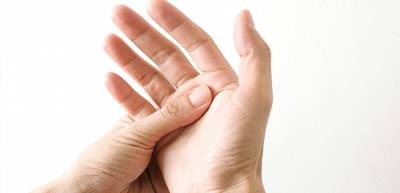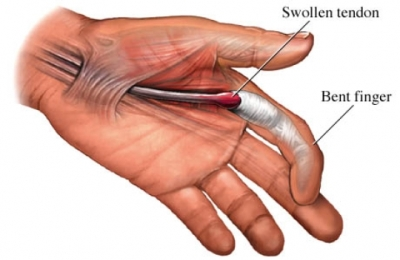Trigger Finger
 In trigger finger, also known as stenosing tenosynovitis one of your fingers or your thumb gets stuck in a bent position and then straightens with a snap — like a trigger being pulled and released. If trigger finger is severe, your finger may become locked in a bent position.
In trigger finger, also known as stenosing tenosynovitis one of your fingers or your thumb gets stuck in a bent position and then straightens with a snap — like a trigger being pulled and released. If trigger finger is severe, your finger may become locked in a bent position.
Often painful, trigger finger is caused by a narrowing of the sheath that surrounds the tendon in the affected finger. People whose work or hobbies require repetitive gripping actions are more susceptible. Trigger finger is also more common in women and in anyone with diabetes.
Trigger finger more commonly occurs in your dominant hand, and most often affects your thumb or your middle or ring finger. More than one finger may be affected at a time, and both hands might be involved. Triggering is usually more pronounced in the morning, while firmly grasping an object or when straightening your finger.

- Treatment
In more severe cases an injection of a steroid medication, near or into the tendon sheath also can be used to reduce inflammation of the sheath. This treatment is most effective if given soon after signs and symptoms begin. Injections can be repeated if necessary, though repeated injections may not be as effective as the initial injection. Steroid injections may not be as effective in people with other medical conditions, such as rheumatoid arthritis or diabetes.
Surgery is performed when conservative treatment has failed. The goal of surgery is to widen the opening of the tunnel so that the tendon can slide through it more easily. This is usually done on an outpatient basis, meaning you will not need to stay overnight at the hospital. Most people are given an injection of local anesthesia to numb the hand for the procedure.
The surgery is performed through a small incision in the palm or sometimes with the tip of a needle. The tendon sheath tunnel is cut. When it heals back together, the sheath is looser and the tendon has more room to move through it.
Most people are able to move their fingers immediately after surgery.It is common to have some soreness in your palm. Frequently raising your hand above your heart can help reduce swelling and pain. Recovery is usually complete within a few weeks, but it may take up to 6 months for all swelling and stiffness to go away. If your finger was quite stiff before surgery, physical therapy and finger exercises may help loosen it up.
- Recovery time
- 1-2 weeks
- Price range
- 250-350 euro
- Anesthesia type
- Local anesthesia














